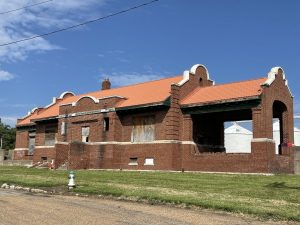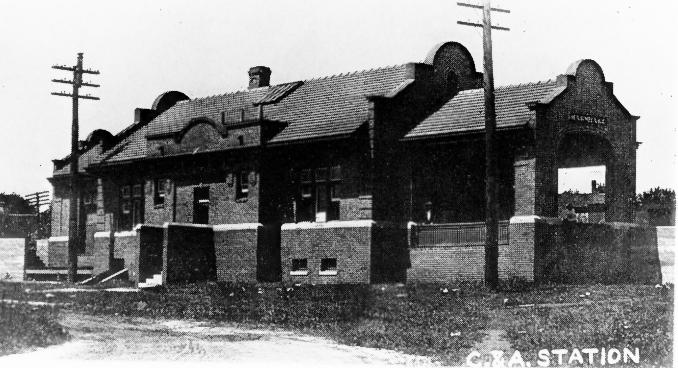
By Whitney Barnes
Staff Writer
As you head to the north side of Marshall, you can’t miss this distinctive building. Its current state exudes an eerie atmosphere. The once-pristine facade now bears scars, with worn wooden boards covering the windows and graffiti hinting at acts of vandalism.
It’s hard to imagine that it wasn’t always like this, but it wasn’t. Once, it stood as a bustling Chicago & Alton train depot, radiating with life and serving as a vital center of activity and connectivity.
The Chicago & Alton railroad holds the distinction of being the first railroad established in Saline County. Its tracks reached Marshall in early October 1878, marking a significant development for the area.
On October 4, 1886, Marshall’s original Chicago & Alton Depot, also known as the Illinois Central Gulf Depot, was consumed by fire. In the aftermath of this event, passenger service was temporarily relocated to the freight depot.
In 1906, this historic train depot was built to replace the one that had burned down a decade earlier. It was designed by the renowned architect Jarvis Hunt and built by E.R. Page, a local contractor. The depot was constructed using what were said to be the finest available materials. Its exterior is a blend of red brick and stone, combining Jacobethan Revival and Mission styles, and has remained virtually unchanged since its construction.
The depot has a length of approximately 113 feet and 2 inches and a width of 42 feet and 11 inches at its widest point. It originally had a clay tile roof, which has since been replaced by a shingle roof. At each end of the building are curved cement stairs that once lead visitors from street level to a brick waiting platform. Inside the depot, the west end would have contained a freight and baggage room for travelers’ belongings, while the east end housed a passenger pavilion. In the central part of the building were waiting rooms and a ticket office, making it a hub of activity during its heyday.
Today, the historic train depot is a tangible reminder of the Chicago & Alton Railroad Company’s significant impact on Saline County’s economic development. The expansion of Saline County communities was closely tied to the westward progress of the railroad. Several “railroad towns” emerged, including Norton, Shackelford, Gilliam, Blackburn, Mt. Leonard and Slater.
The town of Marshall experienced significant growth following the introduction of the C & A Railroad. Established in 1839 by immigrants from Virginia, Tennessee and Kentucky, Marshall — the county seat of Saline County — initially experienced slow growth due to its inland location. The town’s development was further impeded by the challenges of the Civil War, and by 1870, Marshall’s population stood at only 924 people. However, just three years after the arrival of the C & A Railroad in 1881, the population had surged to 3,000.
Unfortunately, The Chicago & Alton Railroad faced financial difficulties and was eventually taken over by the Baltimore & Ohio Railroad in 1929 to avoid bankruptcy. The Baltimore & Ohio Railroad continued to run the line until it was sold to the Gulf, Mobile & Ohio Railroad in 1947.
Passenger service continued to decline, and on Friday, April 15, 1960, the last passenger train passed through Marshall. However, GM & O continued to utilize the depot for freight.
In 1973, the railroad was sold once again, this time to Illinois Central Gulf Railroad, a subsidiary of Illinois Central Industries. Within a few years, the ICG ceased all operations from the Marshall depot, and by the fall of 1977, a dispatcher for local freight trains only occasionally used it. In 1978, all operations at the depot were discontinued. Information about the ownership of the train depot after ICG in 1979 could not be found. Marshall residents Paul and Kim Thompson purchased the building approximately 15 years ago and still own it today.
When asked about the train depot’s future, Kim Thomspon said they had several ideas over the years, but their initial dream was to turn it into a restaurant.
“We went back and forth on what type,” she said. “Would it be a fancy sit-down establishment, or would it be more of an old-fashioned diner? We ultimately wanted to make it something affordable to everyone, because we felt that such a neat place of history should be a place everyone could afford to experience.”
Thompson said the property was ultimately put on the back burner over the years as the couple focused on other business ventures. One of their projects included reopening the old B&B Theatre in Marshall.
“Keeping the movie theater open … seemed more pertinent at the time,” she said. We talk about it regularly (still) and hope that someday it might come to fruition and be a place where people can go to explore a piece of history in Marshall.”
Thompson said potential buyers for the building had approached them at least ten times in the past 15 years, but no deals have materialized.
“Though we have never listed it for sale, we were always willing to entertain offers so that if someone else had the time and the funds, the building could still get revamped even without us,” she said. “Nobody ever pursued purchasing it after seeing how much work it needed, as it is bare bones on the inside and will require a lot of financial investment.”
While its fate seems uncertain, looking back, it’s clear that this structure played a pivotal role in shaping the town’s identity. Without its presence in the past, the city might not have evolved into what it is today.
The old C & A Train Depot is located on the north side of Sebree Street, approximately four blocks north of downtown Marshall. The landmark was added to the National Register of Historic Places in 1979.
Some information for this article was found on the original National Register of Historic Places inventory – nomination form completed by Donna M. Gibbs, President of the Saline County Historical Society, on April 3, 1979.




